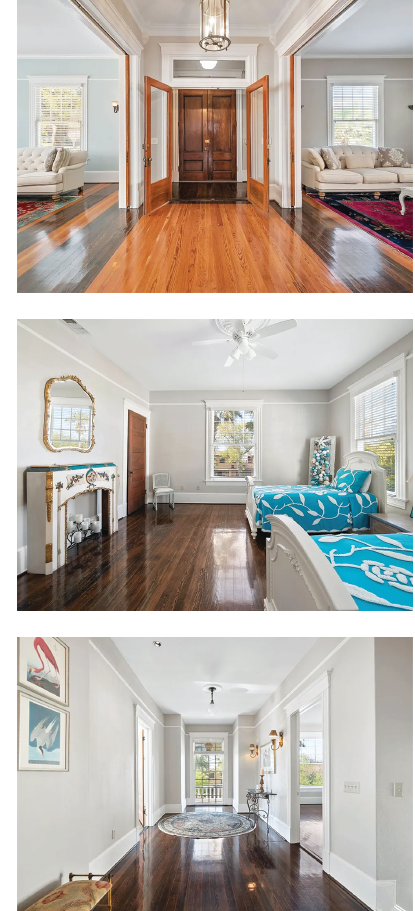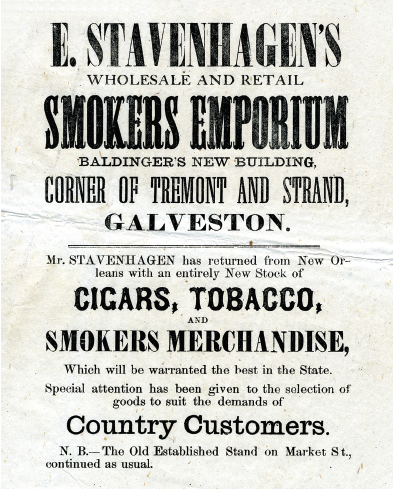A grand residence has graced an oversized lot in the East End Historic District on the southeast corner of Postoffice and 16th streets for more than 120 years. The home was built by the Stavenhagen family, descendants of German immigrants, who found their American dream in our island city.
Ernest Charles Gottlieb Stavenhagen (1844-1920) immigrated to the United States from Germany in October of 1860. He sailed here as a teenager aboard the vessel Fortuna. Within a year, he enlisted in the Confederate Cavalry and served as chief bugler of the 26th Texas Regiment.
It was an interesting use of the young man’s musical background. He served for four years, spending the last part of his service as a prisoner of war, and was paroled in Galveston on June 23, 1865.
By 1870, Stavenhagen established himself as a tobacconist with his Island City Segar (sic) Store on Market Street. He advertised cigars, pipes, snuff, and smoking and chewing tobacco.
The business was short-lived and Stavenhagen began clerking with prominent commission merchants and wholesale traders including Evans & Company and G. Seeligson & Company. There he learned the trade from successful entrepreneurs.
Just after the new year in 1879, Stavenhagen married Galvestonian Julia Koenig (1860-1932) at the home of her mother at 1502 20th Street.
Her father Valentine Koenig, who had owned a beer saloon on Postoffice Street, had passed away six years earlier. Julia’s German grandparents came to the island in 1846 aboard the ship Orient.
The couple had two children: Ernest Charles Stavenhagen II (1879-1971) and Lottie Stavenhagen (1880-1948). Both offspring were musically talented.
Lottie, who never married, devoted her life to the study, enjoyment, and performance of music as a vocalist, pianist, and educator. She was a member of several local musical societies, including the Mignonettes, who would provide both public and private performances.
Stavenhagen was active in community and business organizations and served as an officer in the Masonic Lodge and the local Order of Heptasophs, a fraternal organization founded in New Orleans in 1852.
From 1881 to the early 1890s, Stavenhagen worked as a clerk and salesman for Heidenheimer Brothers, one of the largest wholesale grocers in Texas.
After spending two decades working for some of the most successful wholesale operations in Galveston, he became a partner with Jake Davis, Henry L. Stern, and Morris Lasker.
Together, they opened Jake Davis & Company on Mechanic Street in 1895. The new wholesale company dealt in groceries, wine, liquor, and cigars.
 At the time, the merchant and his family lived at 2124 Avenue M, just a couple of blocks away from the residence of W. L. Moody, whom he knew through social connections. This undoubtedly proved valuable in obtaining a clerk position with Moody’s firm for his 18-year-old son Ernest in 1898.
At the time, the merchant and his family lived at 2124 Avenue M, just a couple of blocks away from the residence of W. L. Moody, whom he knew through social connections. This undoubtedly proved valuable in obtaining a clerk position with Moody’s firm for his 18-year-old son Ernest in 1898.
Ready to strike out on their own as independent businessmen, the father and son opened Stavenhagen & Son, commission merchants, in 1901 on The Strand at 21st Street. Among their offerings mentioned in advertisements were produce, fruit, butter, eggs, and poultry.
By the age of 69, the elder Stavenhagen had achieved enough success to build an impressive two-story home in 1913. The large entry portico was flanked by columns, inviting guests onto double-galleried porches where island breezes could be enjoyed.
The spacious residence featured four bedrooms, two bathrooms, four porches, two brick fireplaces, a kitchen, dining room, music room, living room, butler’s pantry, electric lighting, and gas heating. A wooden cistern and servants’ quarters sat at the rear of the property.
The family, and number of residents in the home, grew in June 1918, when Ernest Jr. married Henrietta Kressman (1895-1966). Henrietta’s late father had been the driver of an ice wagon on the island. After their honeymoon, they moved into the Stavenhagen home to live with his parents.
 When the elder Stavenhagen passed away at the family home on November 2, 1920, his funeral services were held at the residence. Many noteworthy Galveston citizens attended the graveside service in what is now known as Old City Cemetery. Pallbearers included J. J. Schott and John Adriance.
When the elder Stavenhagen passed away at the family home on November 2, 1920, his funeral services were held at the residence. Many noteworthy Galveston citizens attended the graveside service in what is now known as Old City Cemetery. Pallbearers included J. J. Schott and John Adriance.
His son assumed the proprietorship of the family business, but he and his wife moved into their own home at 1701 Church Street. There they raised their own family, which included sons Ernest III and Lee, and daughter Retta (short for Henrietta) Lou.
The Stavenhagens gained new neighbors when Sacred Heart Convent moved into the Adoue home across the street in 1927. It would later be used as the Sacred Heart Academy and Music Hall when the Dominican High School was constructed next door in 1940.
Lottie lived at 1527 Postoffice with her mother until she passed away in October 1932, two days before the twelfth anniversary of her father’s death. Her funeral, like her spouse’s, was held at the residence.
The home provided an income for Lottie, as she leased rooms to female boarders, who also provided companionship. She taught piano there, and Goggan’s Music Store listed her as a highly recommended instructor to their clients.
Well-known in music circles, Lottie directed the young people’s choir of the First Presbyterian Church and taught Sunday school classes there. She was active in the church’s Women’s Auxiliary and often hosted their meetings in her home and held bible studies there. She also worked as a substitute teacher for island schools.
Lottie remained in her family home until she passed away in February 1948. Her brother Ernest sold the home to Edmund Joseph Cordray (1879-1965), a local drugstore owner, who used it as a rental property.
Since 2000, the home has had six owners and is currently on the market. Michael Cordray of the television show Restoring Galveston is handling the sale through his agency Save 1900 Realty.
He is also, coincidentally, the great grandnephew of one-time owner Edmund J. Cordray.